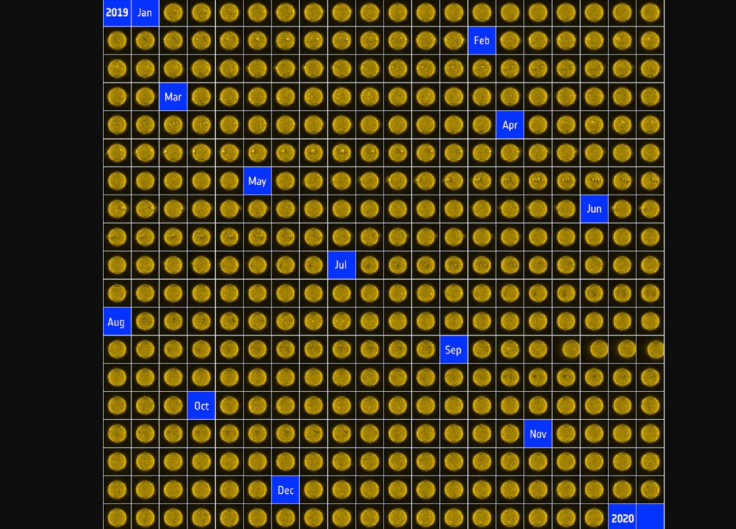365 Suns: ESA Montage Photo Shows The Sun Each Day In 2019
KEY POINTS
- The ESA released a montage image of 365 Suns, with each Sun representing a day in 2019
- The images were taken by the ESA's Proba-2 satellite
- The photo shows low solar activity throughout the year
- Our Sun is currently at its minimum in the 11-year cycle
Every 11 years or so, the Sun’s north and south poles completely flip, switching places until another 11 years when they will switch back again. This solar cycle affects the activity on the surface of the Sun and, in a new image shared by the European Space Agency (ESA), we can see just how the Sun behaved every single day of the year in 2019.
365 Suns
The European Space Agency (ESA) just released a montage image of 365 Suns, each representing a single day in 2019. According to the ESA, the images show that the activity level of the Sun throughout the year was quite low as it is at the minimum level of the current 11-year activity cycle.

The Sun’s most energetic flare of the year, according to the ESA, occurred on May 6 when the solar flare was classified as C9.9. A “C” classification is in the middle of the scale where A is the smallest, followed by B, C, M, and X. Each letter represents a ten-fold energy increase in energy output.
In October 2019, the ESA also released a montage of 10 photos of the Sun representing the 10 years of its operation in orbit since it launched in November 2009. The montage nicely demonstrates how the 11-year solar cycle affects solar activity, with 2010 displaying minimum activity until 2014 when it enters the maximum activity. By 2019, it has calmed down again to enter minimum activity.

Scientific Campaigns
Proba-2 supported various scientific campaigns, such as NASA’s Parker Solar Probe mission, last year. The entire satellite was reoriented so that it can observe more of the Sun’s atmosphere. The changes to support the mission can be observed in the images for early September.
According to the ESA, the satellite will continue to support other missions, such as their own Solar Orbiter mission that will launch from Cape Canaveral this coming Feb. 5.
“With its suite of 10 state-of-the-art instruments, Solar Orbiter will perform unprecedented close-up observations of the Sun and from high-latitudes, providing the first images of the uncharted polar regions of the Sun, and investigating the Sun-Earth connection,” ESA said. “The mission will provide unprecedented insight into how our parent star works in terms of the 11-year solar cycle, and how we can better predict periods of stormy space weather.”
Proba-2
The Proba-2 is a microsatellite developed by Verhaert Space (now Qinetiq Space) for solar observation as well as space weather forecasting. Further, it is also a technology demonstration mission to test new satellite technologies.
Originally, the mission was supposed to last for just two years or only until October 2011. However, the committee extended the mission multiple times and it is now part of ESA’s Space Situational Awareness program. Since all critical systems and subsystems are still working properly, there are still no constraints on how long the mission will last.

© Copyright IBTimes 2025. All rights reserved.






















